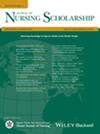Supporting Nurse Leaders to Recognize and Intervene in Team Members' Suicidality
Abstract
Introduction
Nurses and healthcare support staff have a higher suicide risk than the public. This elevated risk calls for increased efforts to support mental health. Additionally, nursing leaders' education on employee-specific suicide prevention is lacking.
Design
An evidence-based project was implemented using the PICO question: Among nurse leaders at an academic healthcare system in California, does the provision of an educational program using role-playing practice and the creation of a suicide prevention toolkit versus no standard education or training improve self-efficacy and knowledge on how to take action with a team member who is suspected of being suicidal or voicing suicidal ideation?
Methods
Education sessions were planned based on the literature, with surveys collected preintervention, immediately posteducation, and 1-month postintervention to assess suicide prevention self-efficacy and knowledge. Knowledge was measured using a researcher-constructed questionnaire validated by six suicide prevention experts. The General Self-Efficacy Scale (range: 10–40) was used.
Results
Sixty participants attended one of 11 scheduled remote-learning sessions. Mean self-efficacy significantly improved (pre: 31.3 [n = 46, min: 18, max: 40]; immediate post: 33.49 [n = 37, min: 24, max: 40]; 1-month post: 33.77 [n = 31, min: 28, max: 40]) (X 2 = 8.0184, df = 2, p = 0.01815). The proportion of incorrect knowledge questions was significantly lower postintervention (mean pre: 24.5%, immediate post: 11.5%, 1-month post: 10.7%, X 2 = 23.195, df = 2, p = 0.000001). All participants (100%, n = 55) recommended the program. Leaders reported feeling better prepared to support suicidal employees.
Conclusion
Project results demonstrate the need to provide suicide prevention training for leaders. The authors recommend requiring training/return demonstration competency as a component of new leaders' onboarding. This program can easily be modified for nurses from prelicensure through senior leadership.
Clinical Relevance
Suicide rates in healthcare members are higher than those of the general population. Suicide prevention programs can help nursing leaders feel better prepared to support and connect at-risk healthcare workers with resources.





 求助内容:
求助内容: 应助结果提醒方式:
应助结果提醒方式:


